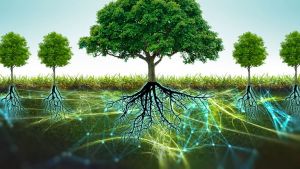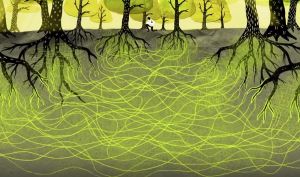Mycelium: Difference between revisions
Florez4747 (talk | contribs) |
Florez4747 (talk | contribs) |
||
| Line 24: | Line 24: | ||
== Mycofiltration == | == Mycofiltration == | ||
Mycofiltration is the process of using Mycelium as a membrane to filter out microorganisms, pollutants, and silt. <blockquote>Habitats infused with mycelium reduce downstream particulate flow, mitigate erosion, filter out bacteria and protozoa, and modulate water flow through the soil. More than a mile of threadlike mycelial cells can infuse a gram of soil. These fine filaments function as a cellular net that catches particles and, in some cases, digests them. as the substrate debris is digested, microcavities form and fill with air or water, providing buoyant, aerobic infrastructures with vast surface areas. Water runnoff, rich in organic debris, percolates through the cellular mesh and is cleansed. When water is not flowing, the mycelium channels moisture from afar through its advancing fingerlike cells. <Ref>Paul Stamets, Mycelium Running, Page 58</Ref></blockquote> | Mycofiltration is the process of using Mycelium as a membrane to filter out microorganisms, pollutants, and silt. <blockquote>Habitats infused with mycelium reduce downstream particulate flow, mitigate erosion, filter out bacteria and protozoa, and modulate water flow through the soil. More than a mile of threadlike mycelial cells can infuse a gram of soil. These fine filaments function as a cellular net that catches particles and, in some cases, digests them. as the substrate debris is digested, microcavities form and fill with air or water, providing buoyant, aerobic infrastructures with vast surface areas. Water runnoff, rich in organic debris, percolates through the cellular mesh and is cleansed. When water is not flowing, the mycelium channels moisture from afar through its advancing fingerlike cells. <Ref>Paul Stamets, Mycelium Running, Page 58</Ref></blockquote> | ||
[[Paul Stamets]] created a method of utilizing Mycelium to filter downstream water flows/ other sources of water; Using the Mycelium to filter out disease, fecal matter, and other contaminates. The method involves inoculating wood chips or straw bales with Mycelium and placing them around water sources or downstream from contaminated water sources. | [[Paul Stamets]] created a method of utilizing Mycelium to filter downstream water flows/ other sources of water; Using the Mycelium to filter out disease, fecal matter, and other contaminates. The method involves inoculating wood chips or straw bales with Mycelium and placing them around water sources or downstream from contaminated water sources. Choosing best suited strains of mycelium, is necessary, to target specific pathogen carrying insects, like mosquitos, or other contaminates: Staph, coliform, and protozoa. | ||
=== Factory Farms === | === Factory Farms === | ||
Revision as of 19:11, 2 January 2023
Natural Intelligence
Understanding how mycelium works as an organism and the role it plays in our ecosystems has notably shaped how intelligence itself is defined.[1] As the neurological network of nature:
interlacing mosaics of mycelium infuse habitats with information-sharing membranes. These membranes are aware, react to change, and collectively have the long-term health of the host environment in mind. The mycelium stays in constant molecular communication with its environment, devising diverse enzymatic and chemical responses to complex challenges. [2]
The Mycelial archetype
Structures similar to Mycelium can be seen throughout Mother Earth and the universe. Some structures resembling Mycelial networks include patterns of hurricanes, dark matter and the internet, further Mycelial networks resemble patterns predicted by string theory. [3] **add photos of these examples**
Mycelium and the Environment
Habitats across the Earth depend upon Mycelium, a keystone species, to sustain themselves and their soils.[4] Mycelium hold soils together and help aerate them; Mycelium breaks down debris to build new blocks of soil after ecological catastrophes created by humans or otherwise. Mycelial networks partner with bacteria and other microorganisms to break down organic material creating stronger structures of soil. [5]
Mycelial Highways
Mycelium, specifically mycorrhizal fungi, partner with plants, microbes, and other animals below ground through its vast Mycelial network. Through this so called Mycelial Highway, chemicals released by one organism are able to quickly reach other organisms, increasing overall communication and resistance between all. Furthermore nutrients and water are transferred between Mycelial networks to deficient organisms.[6]
The mycelia of fungal species that form exterior sheaths around the roots of partner plants are termed ectomycorrhizal. The mycorrhizal fungi that invade the interior root cells of host plants are labeled endomycorrhizal... Both plant and mycorrhizae benefit from the association. Because ectomycorrhizal mycelium grows beyond the plant's roots, it brings distant nutrients and moisture to the host plant, extending the absorption zone well beyond the root structure. The mycelium dramatically increases the plant's ingestion of nutrients, nitrogenous compounds, and essential elements (phosphorus, copper, and zinc) as it decomposes surrounding debris... Plants with mycorhizal fungal partners can also resist diseases far better than those without. Fungi benefit from the relationship because it gives them access to plant-secreted sugars, mostly hexoses that the fungi convert to mannitols, arabitols, and erythritols. [7]
Mycelial networks are able to transport nutrients between different species of trees:
In one experiment, researchers compared the flow of nutrients via the mycelium between 3 trees: a Douglas fir (Pseudotsuga menziesii), a paper birch (Betula papyrifera), and a western red cedar (Thuja plicata). The Douglas fir and paper birch shared the same ectomycorrhiza, while the cedar had an endomycorrhiza (VAM). The researchers covered the Douglas fir to simulate deep shade, thus lowering the tree's ability to photosynthesize sugars. In response, the mycorrhizae channeled sugars, tracked by radioactive carbon, from the root zone of the birch to the root zone of the fir. More than 9 percent of the net carbon compounds transferred to the fir orginiated from the birch's roots, while the cedar recieved only a smlla fraction. The amount of sugar transferred was directly proportional to the amount of shading. [8]
Mycorestoration
The science behind Mycelium as a mechanism for environmental restoration has not been researched in an extensive manner, likely because of Mycophobia, but this provides new possibilities of reversing the destructive effects of climate collapse.
Mycorestoration is the use of fungi to repair or restore the weakened immune systems of environments. Whether habitats have been damaged by human activity or natural disaster, saprophytic, endophytic, mycorrhizal, and in some cases parasitic fungi can aid recovery. As generations of mycelia cycle through a habitat, soil depth and moisture increase, enhancing the carrying capacity of the environment and the diversity of its members. [9]
Mycofiltration
Mycofiltration is the process of using Mycelium as a membrane to filter out microorganisms, pollutants, and silt.
Habitats infused with mycelium reduce downstream particulate flow, mitigate erosion, filter out bacteria and protozoa, and modulate water flow through the soil. More than a mile of threadlike mycelial cells can infuse a gram of soil. These fine filaments function as a cellular net that catches particles and, in some cases, digests them. as the substrate debris is digested, microcavities form and fill with air or water, providing buoyant, aerobic infrastructures with vast surface areas. Water runnoff, rich in organic debris, percolates through the cellular mesh and is cleansed. When water is not flowing, the mycelium channels moisture from afar through its advancing fingerlike cells. [10]
Paul Stamets created a method of utilizing Mycelium to filter downstream water flows/ other sources of water; Using the Mycelium to filter out disease, fecal matter, and other contaminates. The method involves inoculating wood chips or straw bales with Mycelium and placing them around water sources or downstream from contaminated water sources. Choosing best suited strains of mycelium, is necessary, to target specific pathogen carrying insects, like mosquitos, or other contaminates: Staph, coliform, and protozoa.
Factory Farms
Factory Farms produce mass animal waste in high concentrations and contain toxic organisms/ disease including Pfiesteria, Listeria, Streptococcus, Escherichia coli, amoebic parasites, and other viruses. [11] [12] A clear example of the threat factory farm waste production poses was when
hurricane Floyd hit North Carolina in 1999, the monsoon like rains caused dikes to burst and manure ponds to overflow, flooding thousands of acres with animal feces and causing incalculable health problems both on and off the farms. Residents in Charlotte were rudely awakened to the enormity of the problems by the fouling on their doorsteps. Filth filled the streets and flooded basements. The collateral damage included contaminated wells, fisheries, and crops. Many diseases spread, including ones pathologists are still at a loss to identify...[13]
Factory Farm waste production also pose risks to Indigenous communities. On the Santee Sioux Reservation cattle ranches produce waste, containing fecal coliform bacteria, which accumulate in septic ponds and leaches into the communities water source. The contaminates from the ranches have made the water undrinkable on the reservation. [14]
Bunker Spawn: How To
Mycoforestry
Mycoremediation
Mycopesticdes
Oil Spills
Indigenous Uses
Mycophobia
The fear of mycelium (typically implicit) as usually manifested through a fear of their fruiting bodies (mushrooms) is known as mycophobia.
Pyrolize
"This Underground Economy Exists in a Secret Fungi Kingdom" (https://www.youtube.com/watch?v=WWD_1Nq6iwQ)
"Fungal Banking with Biochar and Hugelkultur" (https://www.youtube.com/watch?v=EoKS07Y1ASk)
"The Organic Internet of a Mycelium Network: Suzanne Simard, Paul Stamets, and Terence Mackenna" (https://www.youtube.com/watch?v=rGyECGJqWDU)
Cited
- ↑ https://microdose-journey.com/mycelium-networks/
- ↑ Mycelium Running, by Paul Stamets
- ↑ Paul Stamets, Mycelium Running, Page 9
- ↑ https://www.nature.com/articles/s41598-019-43980-3
- ↑ Paul Stamets, Mycelium Running, Page 11
- ↑ https://www.cell.com/trends/plant-science/fulltext/S1360-1385(12)00133-1?_returnURL=https%3A%2F%2Flinkinghub.elsevier.com%2Fretrieve%2Fpii%2FS1360138512001331%3Fshowall%3Dtrue
- ↑ Paul Stamets, Mycelium Running, Page 24
- ↑ Paul Stamets, Mycelium Running, Page 24-26
- ↑ Paul Stamets, Mycelium Running, Page 55
- ↑ Paul Stamets, Mycelium Running, Page 58
- ↑ Paul Stamets, Mycelium Running, Page 63
- ↑ https://branchoutnow.org/coronavirus-and-the-climate-a-singular-crisis/
- ↑ Paul Stamets, Mycelium Running, Page 63-64
- ↑ https://branchoutnow.org/growing-sovereignty-part-2-regenerating-sacred-water/

